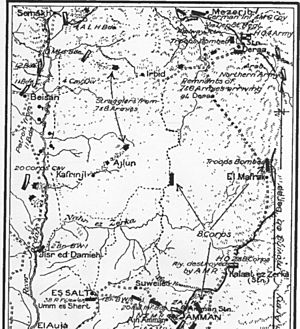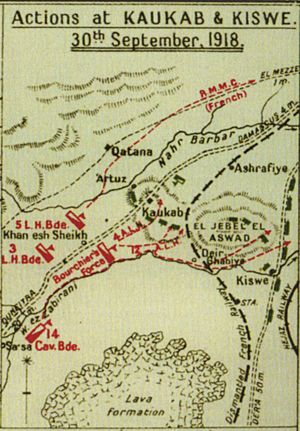Charge at Kiswe facts for kids
Quick facts for kids Charge at Kiswe |
|||||||
|---|---|---|---|---|---|---|---|
| Part of the Middle Eastern theatre of World War I | |||||||
|
|||||||
| Belligerents | |||||||
|
|
|||||||
| Commanders and leaders | |||||||
| Units involved | |||||||
| 5th Cavalry Division Desert Mounted Corps |
remnants of the Tiberias Group a portion of the 24th, 26th and 53rd Divisions and the 3rd Cavalry Division assigned to the defence of Damascus Fourth Army Army Troops/rearguard from Yildirim Army Group |
||||||
| Casualties and losses | |||||||
| 5 killed and 4 wounded | 594 prisoners | ||||||
The Charge at Kiswe was a cavalry attack that happened on 30 September 1918. It took place near Kiswe, about 14 kilometers (9 miles) south of Damascus. This event was part of a larger chase by the Desert Mounted Corps during World War I.
The chase followed a big victory for the Egyptian Expeditionary Force at the Battle of Megiddo. As the Desert Mounted Corps moved towards Damascus, a group of soldiers from the 14th Cavalry Brigade were ordered to charge. Their target was a group of enemy soldiers called a "rearguard." This rearguard was protecting the retreating Ottoman Fourth Army.
After the major battles of Megiddo, the remaining Ottoman forces began to retreat. Some went through Deraa, which was captured by Arab forces. Others headed towards Damascus. The retreating Ottoman and German soldiers tried to set up defenses at places like Samakh and Tiberias. However, these defenses were quickly taken by the Australian Mounted Division.
A group of surviving German and Ottoman soldiers dug in on high ground near Kiswe. They were trying to protect the main Ottoman Fourth Army columns retreating on the Pilgrims' Road. The charge by the 14th Cavalry Brigade broke through these defenses. This caused the Ottoman column to split up and fall into disorder.
Contents
Background to the Attack
The chase towards Damascus began on 26 September 1918. The 4th Cavalry Division moved east from the Jordan River. They went through Irbid to Deraa, which was captured by Arab forces on 27 September. The chase continued north to Damascus, about 225 kilometers (140 miles away). Feisal's Arab forces helped protect the cavalry's right side.
The Australian Mounted Division, with the 5th Cavalry Division, started their own chase on 27 September. They covered about 145 kilometers (90 miles) to Damascus. Their route went around the northern end of the Sea of Galilee, also known as Lake Tiberias.
Ottoman Retreat and Orders
By 26 September, the Ottoman Fourth Army's group from Amman was still strong. Even though they were retreating quickly, they were still able to fight. They moved north towards Damascus along the Hejaz railway and Pilgrims' Road.
Between 6,000 and 7,000 German and Ottoman soldiers had managed to escape. They came from the Fourth, Seventh, and Eighth Armies. They retreated through Tiberias or Deraa before these places were captured.
By 27 September, the retreating columns were north of Muzeirib. They were on their way to Damascus. When Mustafa Kemal Pasha, a commander, reached Kiswe on 29 September, he received new orders. His commander, Otto Liman von Sanders, told him to continue north of Damascus to Rayak.
By the morning of 30 September, the main group of the Fourth Army was nearing Kiswe. This group included Ottoman cavalry and some infantry. The Egyptian Expeditionary Force's 4th Cavalry Division was about 48 kilometers (30 miles) behind them.
5th Cavalry Division's Role
The 5th Cavalry Division had already captured Nazareth and Haifa. They had been following the Australian Mounted Division. Their new order was to cut off the road from Deraa, south of Damascus.
Preparing for Battle
When the 5th Cavalry Division reached Sa'sa at 8:30 AM on 30 September 1918, they received an important order. Major General Henry John Macandrew was told to "intercept a force of 2,000 Turks." An airplane had reported these Ottoman soldiers were retreating towards Damascus.
At this point, the road the 5th Cavalry Division was on was only 14 kilometers (9 miles) from the Pilgrims' Road. The two roads came together as they got closer to Damascus. The 5th Cavalry Division turned east to stop the remaining Ottoman Fourth Army before they reached Damascus. The Essex Battery Royal Horse Artillery (RHA) followed to provide artillery support.
Defending Damascus
Otto Liman von Sanders, the commander of the Yildirim Army Group, gave orders to defend Damascus. He assigned the 24th, 26th, and 53rd Infantry Divisions, along with the 3rd Cavalry Division, to protect the city. Colonel Ismet Bey was in charge of these forces. Other Ottoman groups were told to retreat further north. The Tiberias Group was also ordered to help defend Damascus.
The Battle at Kiswe
As the 14th Cavalry Brigade, the leading part of the 5th Cavalry Division, got close to Kiswe, they saw that the village was strongly defended. Patrols reported that the enemy was also on the hills nearby, called El Jebel el Aswad. The road was full of enemy soldiers and vehicles.
At Kiswe, about 2,000 Ottoman soldiers with machine guns were defending the town. They stopped the advance of the 20th Deccan Horse and the 34th Poona Horse. General Macandrew ordered his troops to go around Kiswe. At noon, he gathered his forces to attack another enemy rearguard about 5 kilometers (3 miles) to the north. He left one squadron of Deccan Horse near Kiswe.
Two squadrons of the 20th Deccan Horse got off their horses to attack. They captured a spot on the El Jebel el Aswad hills overlooking the road. This gave them a good view of the enemy.
The rest of the 14th Cavalry Brigade rode about 0.8 kilometers (0.5 miles) further towards Damascus. They reached a narrow pass that was heavily defended. Through this pass, a large column of enemy soldiers was marching towards Damascus. Many more Ottoman soldiers could be seen further north, also heading for Damascus.
The 34th Poona Horse met a rearguard in a "large stone sangar" (a type of stone fort). A squadron of the 34th Poona Horse charged the sangar on horseback. They were supported by artillery fire. The rearguard immediately "broke and fled" when they saw the charge. The charge continued into the retreating enemy column, splitting it in two. Many enemy soldiers tried to escape east, away from the road. In nearby gardens, 40 officers and 150 men were captured. This was the headquarters and all that was left of one regiment of the 3rd Cavalry Division.
The 14th Brigade camped on the El Jebel el Aswad ridge. They had captured 594 prisoners. The British forces had 5 soldiers killed and 4 wounded.
During the day, five Australian aircraft bombed the retreating Fourth Army columns south of Kiswe. This scattered about 4,000 enemy infantry and cavalry.
Aftermath
At 2:00 PM, a group of the 1/1st Gloucester Hussars went to check on an Ottoman wireless station. They found both the railway and the wireless station burning. They captured some Ottoman soldiers. Then they charged and killed more enemy soldiers before returning to their headquarters.
At 2:30 PM, General Macandrew ordered the 13th Cavalry Brigade to advance from Kaukab to Kiswe. However, they were called back two hours later to guard Kaukab. Meanwhile, a leading squadron of the 9th Hodson's Horse captured 700 prisoners. They then tried to chase a retreating column of about 1,500 enemy soldiers. This attack stopped because they did not get support from their brigade.
Where the Desert Mounted Corps Was
By midnight on 30 September, the Australian Mounted Division was at El Mezze, about 3 kilometers (2 miles) west of Damascus.
The 14th Cavalry Brigade held the last ridge south of Damascus. Other brigades of the 5th Cavalry Division were further back near Kaukab. The 4th Cavalry Division and an Arab force were fighting the remaining Fourth Army around Khan Deinun. An Arab force was also reported to be camped at Kiswe.
General Chauvel ordered the 5th Cavalry Division to move east of Damascus. The 4th Cavalry Division continued its advance from the south.



